Items
Site
The Medicine Chest
keywords is exactly
taxonomies
-
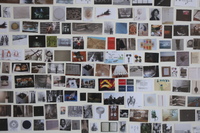
Taxonomy
Visually categorising a selection of my research material (accumulated since 2015). -
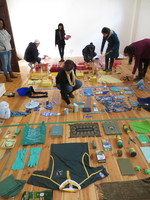
Playtone
Resulting from a 5-day taxonomy workshop which ran from 14 – 18 July 2014 as part of the Honours in Curatorship programme, the PLAYTONE exhibition depicts one of the various exercises students were asked to perform. Colours were allocated to groups, and students instructed to photograph all colour-coded objects during their daily routines, which were then classified using the PANTONE system. In addition to this, students also generated a selection of words they associated with their allocated colours and accumulated colour-coded personal belongings. Participants: Matthew Bradley, Annchen Bronkowski, Thea Ferreira, Sakhisizwe Gcina, Gail Gunston, Sharne McDonald, Mari McFarlane, Mosa Motaung, Thandiwe Msebenzi , Chloe Obermeyer, Bianca Packham, Lindelwa Pepu, Tazz Rossouw, Phenduliwe Sibisi -

Healing instruments
“I invited Edmund February to the Kirby collection to view the instruments and learn his thoughts on them from a botanical perspective. February identified the dancing rattles as being made of the seed pods of Oncoba spinosa (Venda: mutuzwa) and the seed pod of Adansonia digitata (Venda: muvhuyu). The wood of the iodophone was, however, unrecognisable as a result of its handling. February also contacted colleagues in the Department of Zoology and the School of Mathematical & Natural Sciences at the University of Venda, who connected me to a Venda diviner, Muanalo Dyer, who uses similar baobab rattles (and other materials from that tree) in her healing practices. This interdisciplinary engagement showed that these instruments, supposedly frozen in their early 20th century understanding of being on the brink of extinction, remained very much functional in the present” (Liebenberg 2021: 271). -
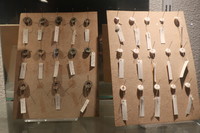
Buttons
A display of a collection of pins, buckles and buttons excavated from the washing pools used by slaves on Table Mountain. Taken from their dusty boxes in storage they are currently exhibited as part of Skotnes's 'Division of the World' (Department of Archaeology). -

Isigubu through Gqom
"In 2018, the Zulu drum alleged to have been played during the 1906 Bambatha rebellion against British rule and unfair taxation in the colony of Natal (discussed by Nixon) became the focus of Amogelang Maledu’s Honours research project. In ‘Isigubu through gqom: The sound of defiance and Black joy’, Maledu (who has an undergraduate degree in Anthropology and Visual Culture) used the drum’s history of colonial resistance and contextualised it through the contemporary musical genre of gqom, showing music as both an act and celebration of joy and freedom and of defiance against the limitations of township life. Through her ‘speculative and imagined interconnectedness’ of the isigubu and gqom, Maledu appropriated the limited information available about the former and expanded it by reinventing new historical pathways that reframed colonial narrations and aesthetics (Maledu 2018: 29–30). Her curation broke the silence of the Kirby instruments and liberated the isigubu from its ethnomusicological framework through a juxtaposition that spoke back to history and the contemporary moment. In addition, a website provides a framework for historicising gqom and encouraged the growth of its archive through viewer engagement, also highlighting the speculative and stagnant colonial archive in which the isigubu is situated (Maledu 2018: 29–30)" (Liebenberg 2021: 211 - 212). -
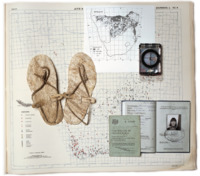
Page 175 of the Curiosity CLXXV catalogue
"The page presents a curated collection of images: a map from the Avian Demography Unit illustrating the distribution of the bataleur Terathopius ecaudatus along the political border, though the bateleur is more frequently found where there is no formal farming; a Ngwato child’s oxhide sandals collected by Isaac Schapera (a British social anthropologist who worked in South Africa and Botswana); a compass; the identification documents of Paula Ensor (previous dean and Professor of Education), who spent time in exile in Botswana; and a Certificate of Registration necessary for movement across borders, all of which are overlaid on top of a large map from the Afrikaans Atlas provided by Rajend Mesthrie of the Department of Linguistics and Southern African Languages that shows the Afrikaans language’s distribution. Contextualising all of these objects in relation to the large map cuts across disciplinary boundaries and illustrates the scope and impact of the colonial and apartheid regimes and their influence on immigration laws, language studies, ornithology and anthropology" (Liebenberg 2021: 193). -

Division of the World
"Undergraduate students regularly engage in discussions around certain displays as part of their teaching programme (N. Zachariou, personal communication, 27 May 2020), and the installation is also used to introduce visitors (exchange students and school children, for example) or students from other UCT departments (architecture students taking the archaeology module) to the department and the discipline (J. Parkington, personal communication, 20 June 2020). It has even been described as a ‘super curriculum’ (or as ‘several super curriculums’) for how it visualises what archaeology does on both an empirical and procedural level (J. Parkington, personal communication, 20 June 2020)" (Liebenberg 2021: 210). -
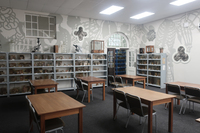
Subtle Thresholds (PLC)
"Integrated into the PLC, these works speak to the specimens on display and provide interesting access points to the collection. The animal-faeces prints (which referenced ‘sites of contamination’ in the context of the SAM exhibition) resonate, for instance, with many of the specimens on display in the PLC, such as the heterotopic heart (also called a ‘piggy-back heart transplant’) created by Dr Chris Barnard in 1977, consisting of a baboon heart grafted onto a human heart for additional motoric support. In addition to their more ‘famous’ specimens, the centre also has an extensive intestinal worm collection and many organs affected by zoonotic diseases, such as a liver ravaged by malaria. This was not a conscious decision on the part of the artist-curator and illustrates how curation can draw attention to aspects of a collection and liberate new associations when brought into conversation with it" (Liebenberg 2021: 201). -
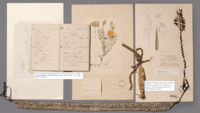
Pages 38-39 of the Curiosity CLXXV catalogue
"Objects and collections can reflect naturalisations that occur when the disciplinary perspective renders its subject matter in terms of what it deems worth looking at and how it should be looked at (Daston & Galison 2007: 23). This process has dual consequences, resulting in the honing of a specialised insider focus directed at the object and a blindness to qualities that sit outside the disciplinary frame of reference (as discussed in relation to the Drennan and Kirby collections). 'Curiosity CLXXV' drew on and challenged both these aspects by forcing objects into visual conversations outside their discipline and inviting insiders to view them in these new configurations. These curatorial strategies enabled insiders to become aware of characteristics not normally deemed important in their discipline and to identify the characteristics their discipline did deem important (their attentional subculture, in other words) in objects not studied in their field" (Liebenberg 2021: 180). -
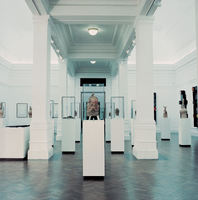
Face value
"In 1993, the [Lydenberg] heads were temporarily moved from the SAM stairs into the SANG as part of Payne’s exhibition. In the gallery context, where ‘the shifting definitions of art, the meaning of objects, the contexts of spaces as well as the politics of culture are continuously examined’ (Martin in Payne 1993: 4), these objects became part of an exhibition of Payne’s own terracotta heads, painted and sculpted cases, etchings inspired by the heads, drawings and a collection of supermarket trolleys" (Liebenberg 2021: 159 - 160). -
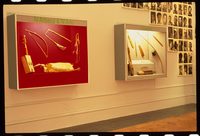
Miscast (installation detail)
Instruments from the Kirby collection displayed as part of the 'Miscast' exhibition. -
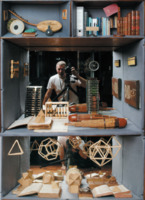
Page 135 of the Curiosity CLXXV catalogue
"Peering into one of them could, for instance, reveal musical instruments from the South African College of Music’s Kirby collection; old wooden mathematical models of abaci and polyhedrons from the Maths department; mobiles demonstrating platonic solids made by mechanical engineering students; publications by a UCT Professor of Astronomy; a sign pointing to ward D10 from the old section of Groote Schuur Hospital; glass slides once used as a teaching aid for art history at Michaelis; bird ringing material from the Avian Demography unit; and a bottle-brush plant labelled by the son of one of the curators" (Liebenberg 2021: 179). -
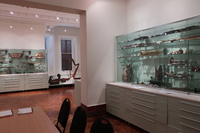
The Kirby collection of musical instruments
"Kirby’s choice of an ‘age-old simple classification’ to order the instruments can be correlated with another classification formulated at Wits around the time he was collecting. The Department of Bantu Studies was established in the 1920s at roughly the same time as the Music Department. Kirby’s use of the phrase ‘native races’, which features in the title of his book, resonates with the descriptive subtitle of the Wits journal connected to research in this department: Bantu Studies: A Journal Devoted to the Scientific Study of Bantu, Hottentot, and Bushman (Nixon 2013: xii). The homogenising act of categorising all diverse indigenous South African groups into three general categories seems to echo Kirby’s taxonomic imposition on the diverse instruments he collected on his trips and that continues to feature as the ordering principle of this collection" (Liebenberg 2021: 136). -
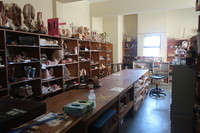
The workshop
"Held in the Department of Human Biology in the Division of Clinical Anatomy and Biological Anthropology, this collection consists of prepared specimens – both bottled and plastinated, anatomical models – and a skeletal repository used for research purposes. The materials are kept in three separate rooms, with the anatomical models in one, the prepared and plastinated specimens in another and the skeleton repository in its own room behind locked doors, viewable by appointment only. The room housing the anatomical models functioned as a workshop when modelmaking was still offered to first year medical students as an elective course: its walls are lined with shelves that display models made from materials ranging from papier-mâché to modern silicon copies and are taxonomised according to their anatomical representations, such as ‘the eye’, ‘head & neck’, ‘dentistry’, ‘embryology’, ‘lungs’ and ‘cardiovascular system’, to name a few. The models represent each anatomical section and are brightly coloured to differentiate the different parts of the human body and aid in identification. Many of the models can be dismantled into separate pieces and, like a puzzle, be reassembled into their original shapes. Interspersed with these models are rolled-up charts depicting organs, bodily systems and anatomical sections of the body in two-dimensional form, as well as old student modelling projects. A selection of animal skeletons is displayed on the far side of the room, and a shelf with a few anatomical specimens in formaldehyde is across from it" (Liebenberg 2021: 121 - 122). -
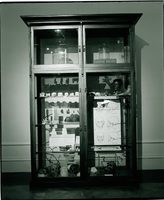
Miscast (installation detail)
"In juxtaposing instruments that are still being used (such as the scalpel and the camera) with ones that are not (the Von Luschan skin colour chart and the anthropometric measuring rods), Skotnes set up an opportunity for science to reflect on its past and on the activities and objects of its present, enabling a mode of self-reflexivity that is not a standard part of its day-to-day practices. Through curatorship, she exposed disciplinary practitioners to naturalisations and blind spots within their fields and sensitised them to these previously occluded characteristics" (Liebenberg 2021: 172). -
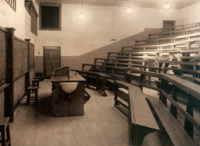
Page 65 of the Curiosity CLXXV catalogue
Page 65 of the 'Curiosity CLXXV' catalogue, showing the Old Anatomy Lecture Theatre (currently part of the Centre for Curating the Archive). -
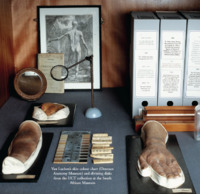
Page 79 of the Curiosity CLXXV catalogue.
"Created by Felix von Luschan, an Austrian doctor, anthropologist, explorer, archaeologist and ethnographer in the early 20th century, the chart, known as the Von Luschan chromatic scale (...) was used to classify skin colour and featured as a tool in race studies and anthropometry of the time. Forgotten by its current department staff and students, its presence draws attention to the role of medicine and science in the apartheid agenda and to the larger racist scientific practices of measuring and classifying human physical differences in the 19th and 20th centuries to produce a ‘typology of race’ (Sturken & Cartwright 2018: 351–352). To support such theories, object collections in scientific university departments worldwide also featured collections of human remains; tools for measuring the size and shape of skulls; and charts detailing various physiognomic features (Sturken & Cartwright 2018: 351 – 352)" (Liebenberg 2021: 122 - 125). -
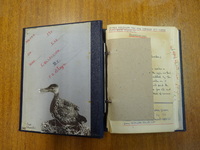
Diary of an oologist
"In 2019, Honours in Curatorship student Nathalie Viruly, who completed her Bachelor of Social Science in Politics and Sociology, was similarly struck by the silence and loss evoked by the [Peter Steyn] collection. Viruly honed in on the moments documented in the notebooks, which capture the loss of life in the reproductive life of these birds and reveal ‘stories of avian tragedy’: Young taken by predator; 1 young accidentally killed; 2 eggs failed to hatch; 2 infertile; Chick disappeared without a trace; Eggs disappeared; Literally cooked by the [corrugated] roof; Nest empty – egg collectors? (Viruly 2018: online). Her focus on these moments in the scientific journal poignantly reveals the conflation between science and emotion and invites the viewer to re-examine hierarchies of loss" (Liebenberg 2021: 219). -
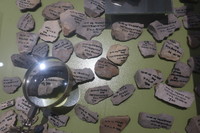
Stone tools
"By positioning artefacts to emphasise their labelling (stones are positioned to reveal the details written on them), including seemingly familiar objects and expanding and shrinking timelines, the installation [Division of the World] draws attention to the framing devices, tools and methods of the department’s insiders" (Liebenberg 2021: 207). -
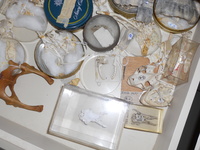
Things zoological insiders look at
A sample box of archaeological specimens shown to first year students. -
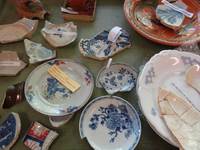
Things archaeological insiders look at
A variety of pottery shards of Asian porcelain, European earthenware and British stoneware in a drawer in the Department of Archaeology, UCT. -
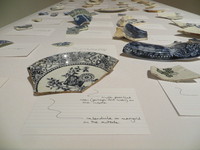
Appendix (installation shot)
A variety of pottery shards consisting of Asian porcelain, European earthenware and British stoneware sourced from the University of Cape Town Archaeology department and subjected to a botanical analysis by a graduate of the Biological Science (Botany) Department. -
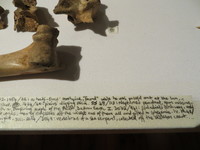
Appendix (installation shot)
A variety of bones sourced from the University of Cape Town Archaeology and Zoology departments, playfully re-imagined by the students as a collection owned by a time-travelling anthropologist - collecting samples across time and sometimes, across dimensions. -
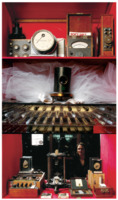
Capitance
"Strategies such as juxtapositioning also served to highlight poetic and emotive qualities in fields not known for encouraging them, as in a cabinet curated by Langerman titled Capitance. This featured a range of instruments from the Physics department used to measure electrical currents (galvanometers, capacitors and Wheatstone bridges); a crystal goniometer measuring crystal face angles and crystal 175 from the crystal collection in Geological Sciences; M.R. Drennan’s models of the human embryo and a wax model of flesh; and a white tutu from the School of Ballet. In combining this selection of scientific instruments with a tutu, Langerman made allowance for the materials to be considered in a more poetic light, inviting the viewer to consider how a grand jeté defies the laws of physics, for example" (Liebenberg 2021: 186). -

Similitude
"In 'Similitude', Langerman brought together a selection of objects from three disparate disciplines – glassware from chemical engineering; a skull with an arrow embedded in it and a torch used as a murder weapon from forensic pathology; and two flutes from the Kirby collection. Ignoring the assigned functions the objects performed within their respective disciplines, she chose instead to use their formal characteristics as a taxonomic device. They were all, as she described them, ‘long thin things’ (Langerman n.d.). In displacing these objects from their respective disciplines and positioning them in proximity to objects that shared this new category, she neutralised their disciplinary functions and flattened their meanings within those fields (Langerman n.d.)" (Liebenberg 2021: 183). -

Rattles in the Kirby collection
A drawer of rattles in the South African College of Music's Kirby collection: "The instruments are now grouped in different cabinets according to the taxonomy set out by Kirby in his book. In the preface to the second edition (1964), Kirby shares some of his considerations when deciding how to group the instruments, writing that he had to decide ‘whether to arrange his material tribally, or to deal with each type of musical instrument separately from the technological and historical points of view, allowing the tribal aspects to emerge incidentally’ (Kirby 1964: xi). Kirby chose the second alternative, stating that his chief reason was that he wanted the work to be, as far as possible, ‘a complete and comparative study of one particular aspect of the life of our aborigines’ (1964: xi). His second consideration was to find the most suitable manner for classifying the instruments, for which he defaulted to the ‘age-old simple classification of musical instruments into three main groups of percussion, wind and strings’ (1964: xi) – a Western system for the classification of instruments and the principles on which they were based. The chapters in his book and the displays in the room are thus grouped into three categories: percussion – ‘rattles and clappers’, ‘drums’, ‘xylophones and sansas’ and ‘bull-roarers and spinning-disks’; wind instruments – ‘horns and trumpets’, ‘whistles, flutes, and vibrating reeds’ and ‘reed flute ensembles’; and stringed instruments – ‘stringed instruments’ and ‘Bushmen and Hottentot violins and the ramkie’. Kirby encountered one taxonomic anomaly when employing this system: the ‘gora’, an instrument both wind and string, which he termed ‘a stringed-wind instrument’" (Liebenberg 2021: 135). -

Curiosity CLXXV
Hiddingh Hall during the construction of the installation of Curiosity CLXXV. -

Hiddingh Hall
Hiddingh Hall prior to the installation of Curiosity CLXXV. -

Miscast (instruments of measurement)
"Along with the guides that regulated practices and protocols to stabilise and standardise an individual’s response to unfamiliar and disorienting sights (Kennedy 2013: 42), the gender, class and ethnicity of the observer were also of importance , as was the use of ‘ever more sophisticated instruments and calculations designed to minimize the intrusion of subjectivity into the reporting of information’ (Driver 2001: 55). By regulating who was doing the viewing, stipulating what should be viewed and how and supplying tools to measure these observations, scientific institutions promoted an authoritative ‘way of seeing’ in the field that differentiated the scientific view from that of the ordinary traveller (Driver 2001: 49)" (Liebenberg 2021: 109). -

175 chalk-board dusters
For the exhibition, 'Curiosity CLXXV', the curators took an old duster from each teaching venue and replaced it with a new one. -

"Bought fresh in streets of Cape Town"
"The flower sellers trading in Trafalgar Place and along Adderley Street have been doing so since at least the mid-1880s but became viewed as threats to the local flora by the European settlers at about the same time the medicine chest was first introduced to the city at the beginning of the 20th century. The settlers initially preferred to cultivate plants imported from their home countries to indigenous varieties, introducing many species to South Africa for nostalgic or practical reasons (subsequently problematic for local biodiversity) (Van Sittert 2002: 103). In the wake of the emerging nationalism of the white settlers in the 1890s, interest in indigenous plants gained momentum and was deployed to create a sense of belonging to the ‘foreign’ land (Boehi 2013: 133). A botanical discourse was mobilised to underscore ideas about identity and belonging, such as ‘roots’ and ‘ideas of rootedness’, and laws regulating flower picking (which usually occurred on the mountain) were passed in this period and were secured by the Wild Flower Protections Act in 1905 and an amendment thereto in 1908 (Boehi 2013: 133)" (Liebenberg 2021: 275). This is a label on a botanical specimen (K000225239) found in the Royal Botanic Gardens of Kew that was donated to the Gardens by UCT. Described in pen in the notes section, the specimen is of the local Erica latiflora and was collected in 1908, when it was ‘bought fresh in the streets of Cape Town’. The insider details noted on this specimen reveal much to outsiders such as Boehi (2013) and Van Sittert (2010) – scholars who have written about the colonial history of botany in the Cape and the unofficial presence of the flower sellers in the provenance of many specimens from the Cape kept in international herbaria. -

"Bought fresh in streets of Cape Town"
Royal Botanic Gardens, Kew (K). Herbarium: Royal Botanic Gardens, Kew (K), K000225239. Collection: Herbarium Specimens. Resource Type: Specimens. Collector: unknown, #14027. Collection Date:11–1908. Locality: Bought fresh in streets of Cape Town. Country: South Africa (South Africa). Identifications: Type of Erica latiflora L.Bolus [family ERICACEAE] (stored under name). Notes: Herbarium Africanum Bolusianum Flora South Western Region -

Avoided Object
Photographs of the sky above the Imperial War Museum taken with the camera that belonged to Hoess, commandant of Auschwitz -
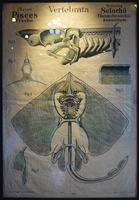
Scientific atlases
"Used from the 18th to the 20th centuries, the scientific atlases provided, for example, simplified, generalised and idealised versions of the objects of anatomy, physiology, botany, palaeontology and astronomy, to name a few, guiding the student and practitioner to what was worth looking at, how it looked and, perhaps most important of all, how it should be looked at (Daston & Galison 2007:23). The establishment and representations of these working sets of objects, and the standardised procedures for studying them, thus extended the initial influence exercised on the individual traveller in the field. By controlling the very act of seeing and by creating a sense of individuals working as members of academic communities, the atlases shaped the subjects and the objects of their disciplines. Processes initiated in the field and reinforced in institutions, societies and museums laid the foundation for procedures still used by the disciplinary insiders of university departments today" (Liebenberg 2021: 111).


